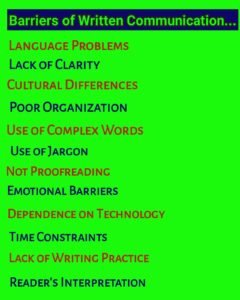Barriers to Written Communication
Introduction:
Effective written communication is very important in education, business, and personal relationships. It helps people share ideas, express opinions, and send messages clearly. However, many problems can stop communication from being smooth. Understanding these problems is very important for students in India. This is because communication skills are necessary for both academic and professional success. The term ‘barrier’ literally means ‘obstacles’. Barriers are the factors which hamper the process of communication.
Various Types of Barriers to Written Communication
1. Language Problems
Many students in India face difficulties with written communication because they are not fluent in English. They may have problems with grammar, vocabulary, and sentence structure. This can make their messages unclear or wrong. When students do not have a strong grasp of grammar, they may make mistakes that confuse the reader. A limited vocabulary can also lead to repetitive or unclear writing. Language problems often result in ineffective communication. In this case, lack of command over language can work as a barrier to communication.
2. Lack of Clarity
When the writer does not know exactly what they want to say, the message becomes confusing. Using unclear words and complex sentences can make readers misunderstand the content. Writers may include too much unnecessary information, making the main message difficult to find. Clarity is essential because readers need to understand the purpose of the message quickly. Without it, the communication fails to achieve its goal. Vague words and sentences with multiple meanings often create confusion in the readers’ mind. Sometimes, one of the meanings is ridiculous. Eg. She made omelette of her husband. This sentence has two meanings and one of them is ridiculous. Its clear meaning is ‘she mad omelette for her husband.’
3. Cultural Differences
India is a country with many different cultures. People from different regions may understand the same message in different ways. This can create confusion when writing to a wider audience. For example, certain phrases or idioms that are common in one region may be completely unfamiliar in another. Writers need to be mindful of these differences to avoid misunderstandings. Some words have culture-based meaning. The words related to food items, cultures, traditions and customs can hardly be translated into other languages. E.g. Sabbath, Jalebi, etc.
4. Poor Organization
If the content is not organized well, readers may find it difficult to follow the message. Without a logical flow, important points can be missed or misunderstood. A poorly structured document can confuse readers, even if the information is valuable. Effective organization includes a clear introduction, well-developed body, and concise conclusion. Headings, subheadings, and bullet points also help make content easier to read. If there is no Cohesion (logical connections/sequences of the sentences), it becomes difficult to understand for the reader. There should be ‘Coherence’ in writing also. That is, there should be logical and proper connection or sequence among the paragraphs also. If proper unity in writing is not maintained, it becomes for the reader to understand the piece of writing.
5. Use of Complex Words
Some writers use technical or difficult words that readers may not understand. This makes the communication less effective. While technical language may be appropriate for experts, it can confuse general readers. Using simple and straightforward words makes communication more accessible. Writers should always consider the knowledge level of their audience.
6. Use of Jargon
The term ‘Jargon’ refers to the words from local languages. Sometimes writers use technical or complex words that the reader may not understand. This creates a gap in communication and makes the message less effective.
7. Not Proofreading
Errors in spelling, grammar, and typing often happen because writers do not proofread their work. These mistakes reduce the quality of the message. A single typo can change the meaning of a sentence and create confusion. Proofreading helps identify and correct errors before the content is shared. It ensures that the final message is polished and professional.

8. Emotional Barriers
Fear of making mistakes or being judged can stop students from writing clearly. This limits their ability to communicate well. Some students may hesitate to write because they worry about negative feedback. This fear can lead to incomplete or poorly written messages. Overcoming emotional barriers requires confidence and regular practice.
9. Dependence on Technology
Typing errors, autocorrect mistakes, and overuse of digital tools can make the message unclear or wrong. While technology can help improve writing, it should not replace careful thinking and editing. Overreliance on spell-checkers and grammar tools can result in overlooked mistakes. Writers should use technology as a tool, not a crutch.
10. Time Constraints
Sometimes writers have limited time to complete their work. This can lead to hurried and poorly written content. Rushed writing often lacks clarity, organization, and proper proofreading. Taking sufficient time to plan, write, and edit ensures better communication.
11. Lack of Writing Practice
Many students do not get enough practice in writing. This affects their ability to communicate effectively. Writing is a skill that improves with regular practice. Without it, students may struggle to express their thoughts clearly and concisely. Continuous practice helps develop better writing habits.
12. Reader’s Interpretation
Even when a message is written clearly, different readers may interpret it in different ways. This can lead to misunderstandings. Writers should try to anticipate how readers might interpret their words and provide context when necessary. Clear examples and explanations help reduce the chances of misinterpretation.
Conclusion
Thus, Lack of Language Proficiency, lack of clarity, poor organisation, cultural differences, use of technical and complex words, use of jargons, emotional constraints, time constraints, not proof reading, time constraints, lack of writing practice, reader’s interpretation, etc. factors work as Barriers to effective Written Communication. Barriers to written communication can be challenging, but understanding them is the first step to improvement. By being aware of these barriers, students can work towards improving their writing and becoming better communicators. Effective communication is essential for success in academics and professional life. Students must recognize that written communication is a valuable skill that requires effort, practice, and careful attention to detail. Addressing these barriers can help them achieve greater success in their studies and future careers.
See More
Basics of Written Communication
Types of Written Communication

